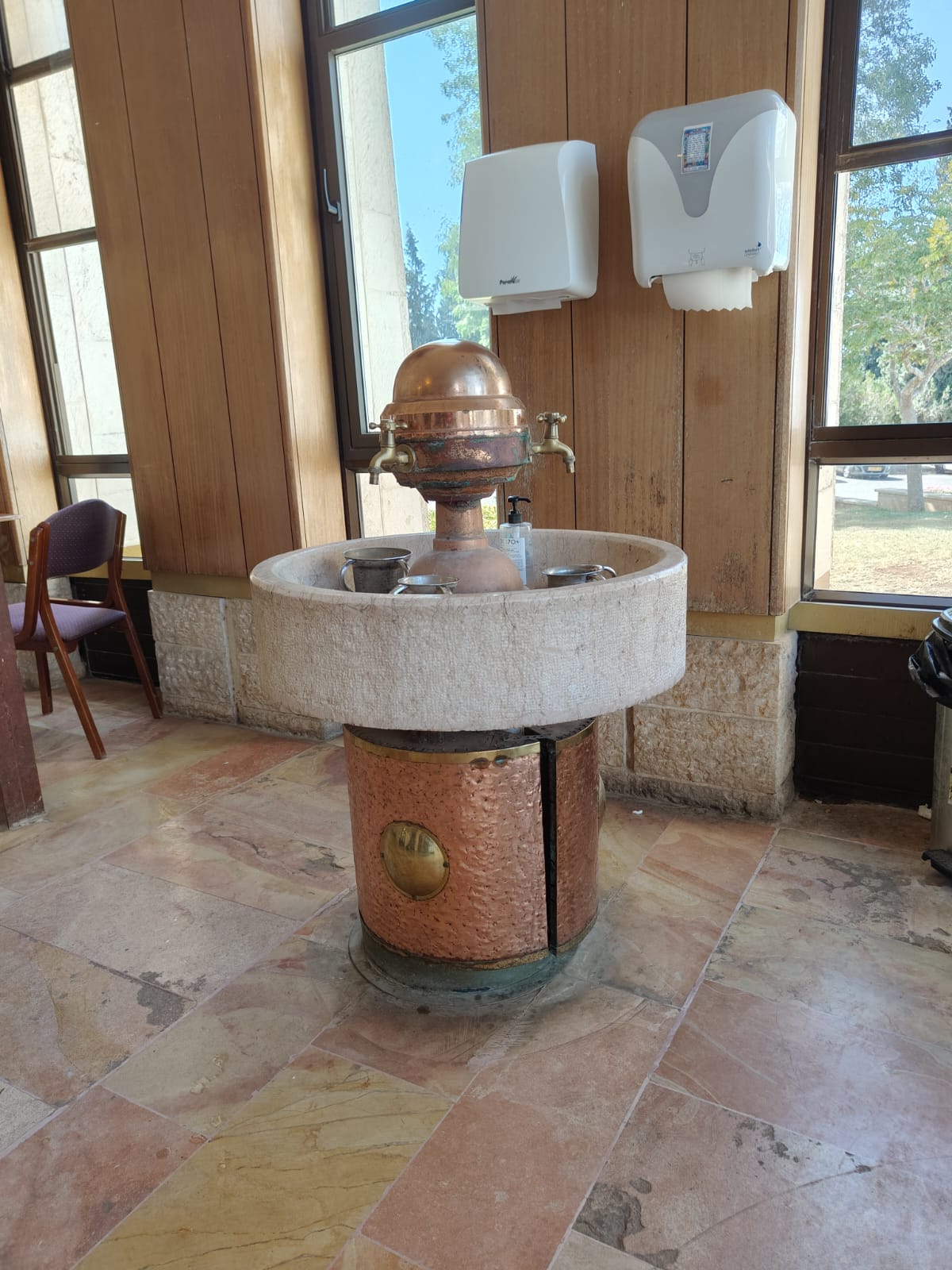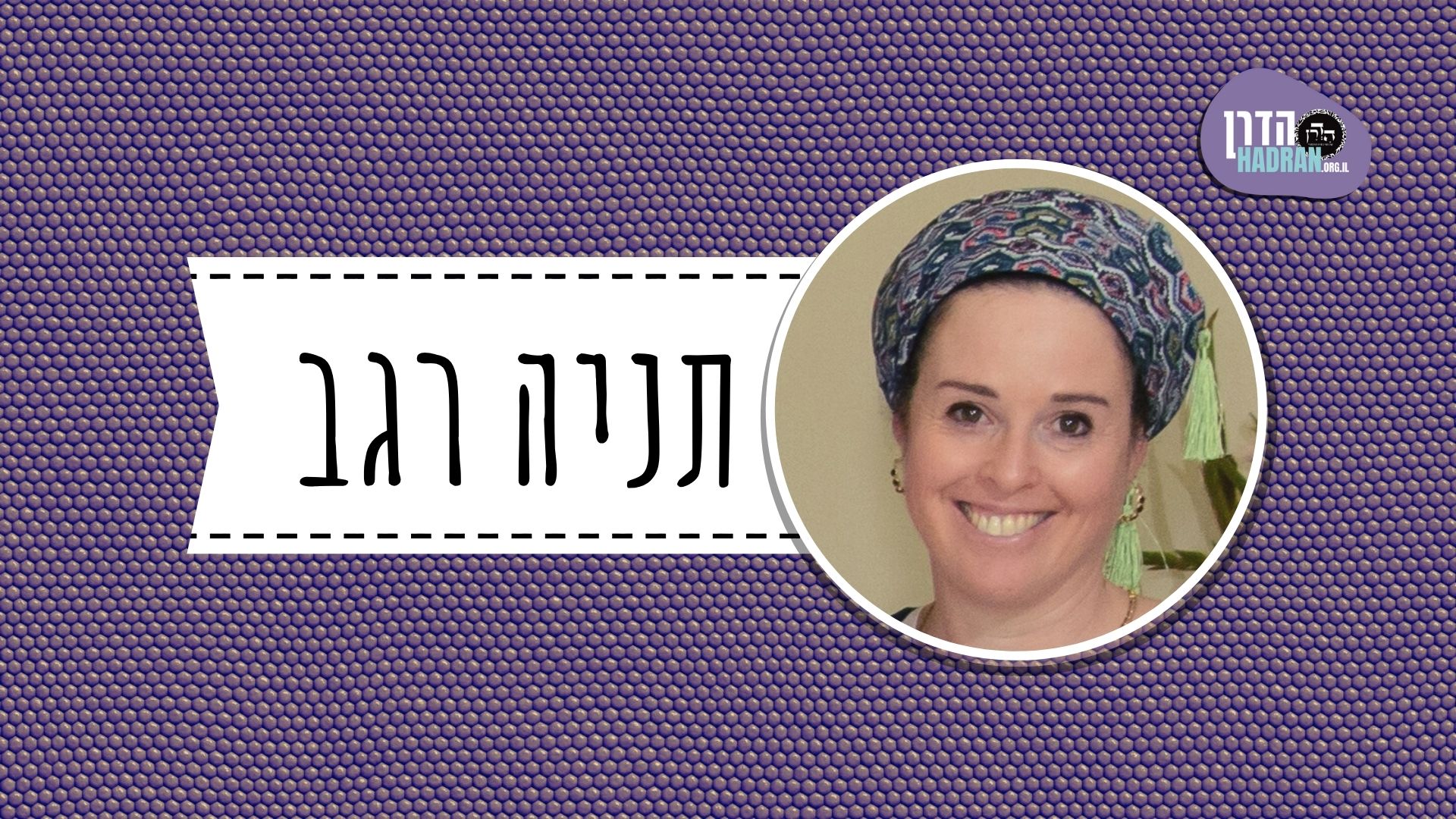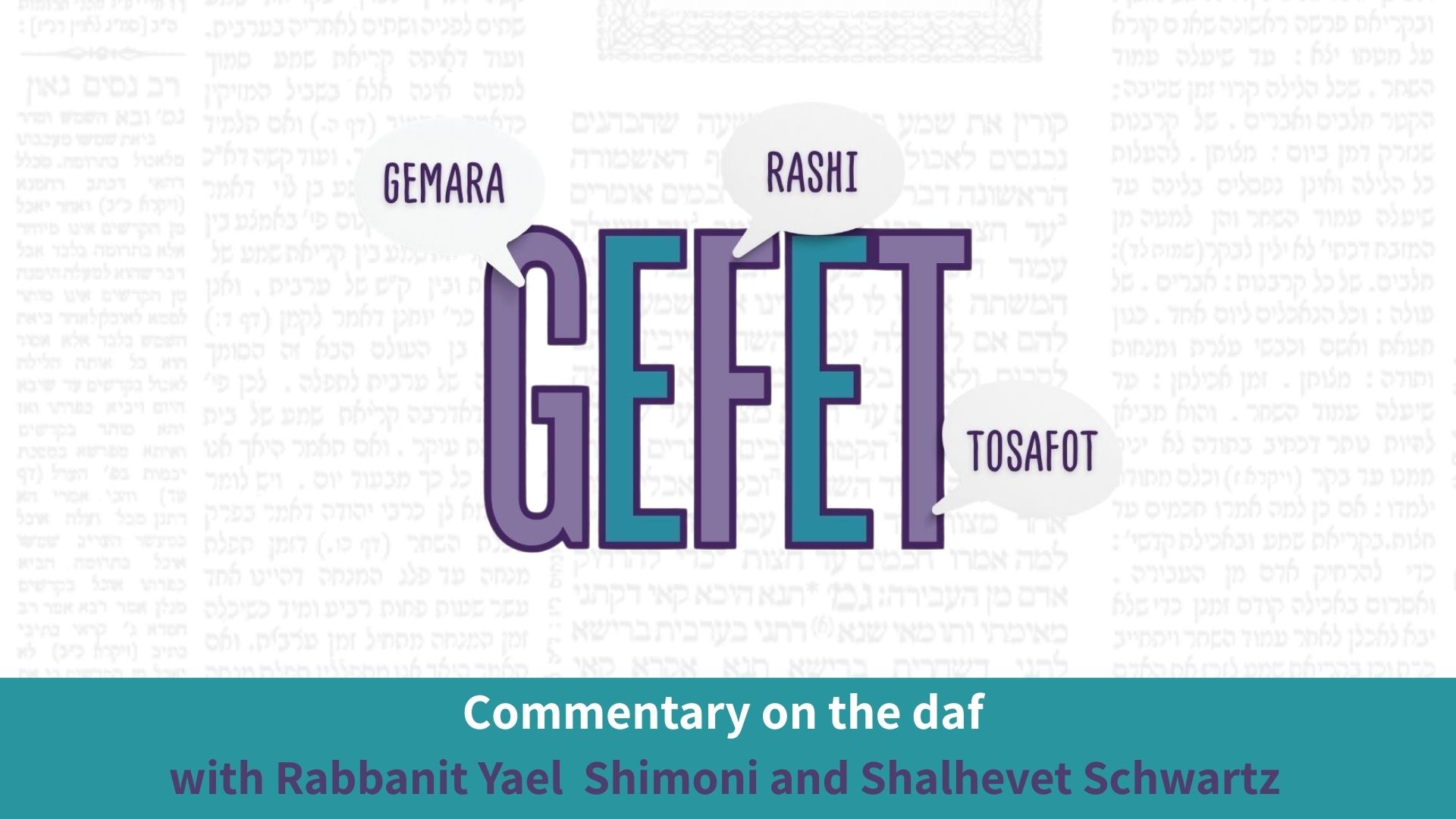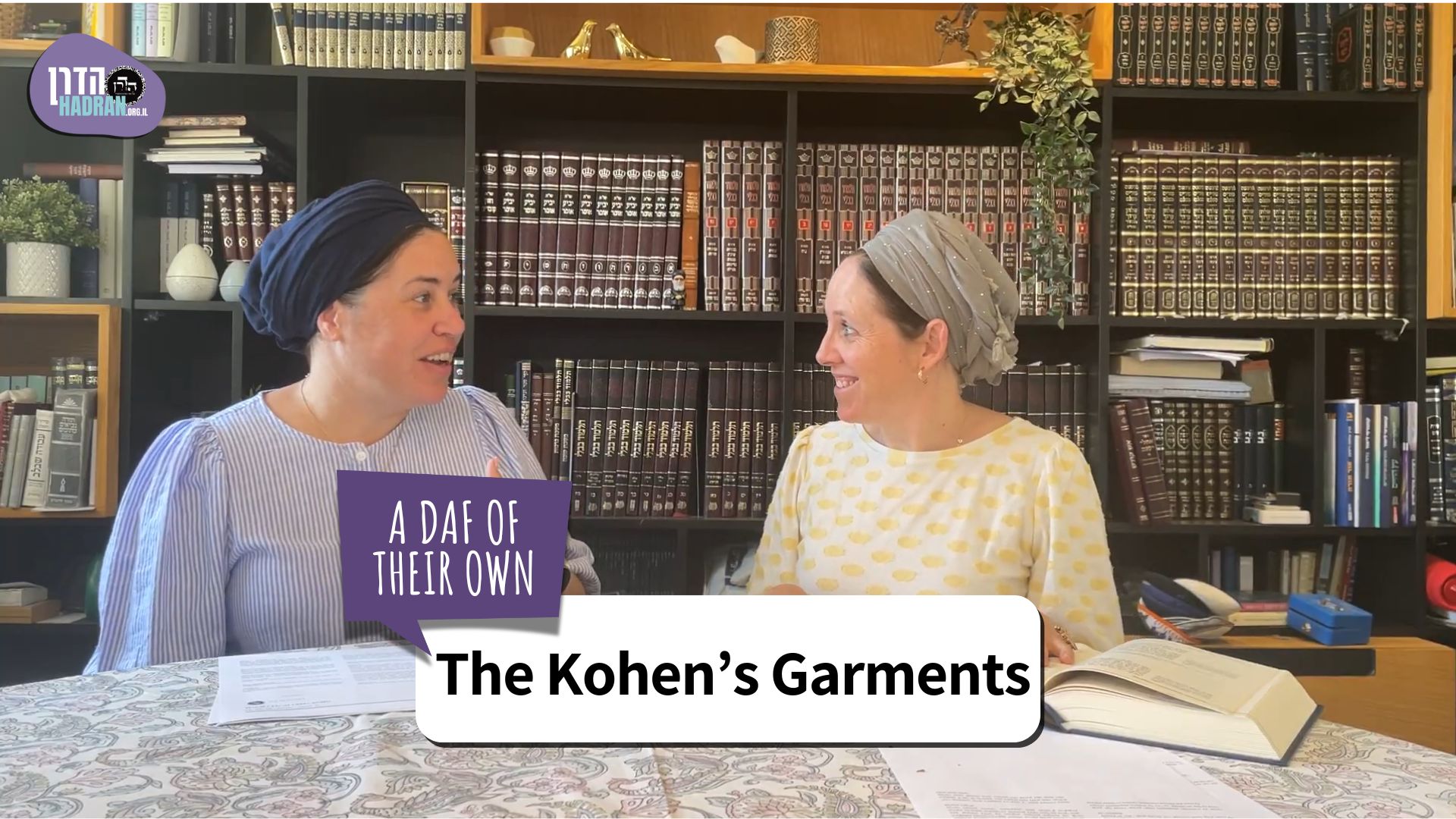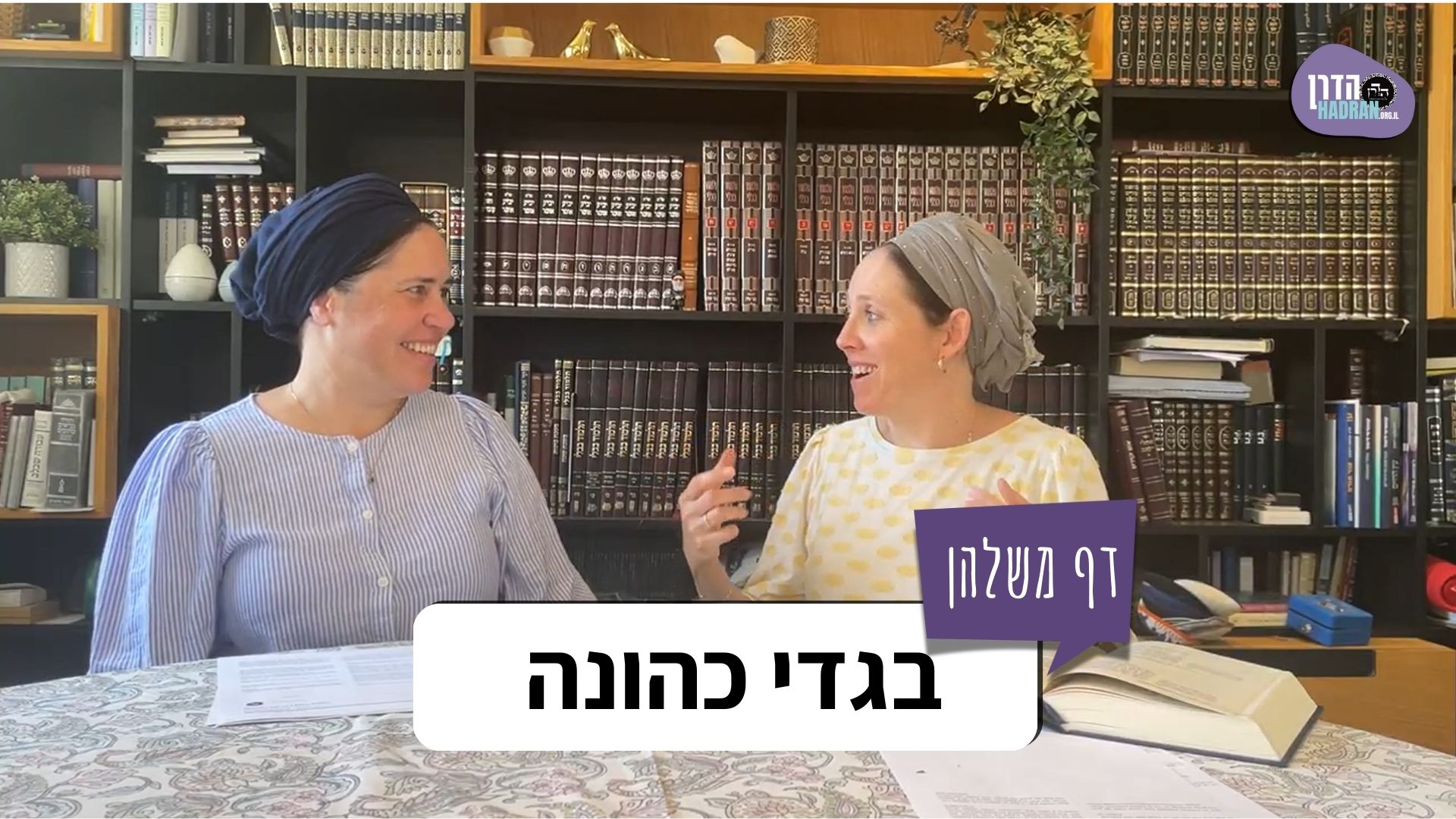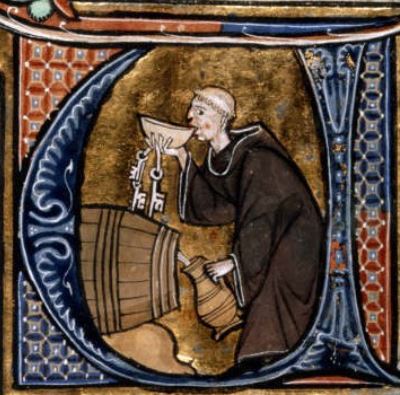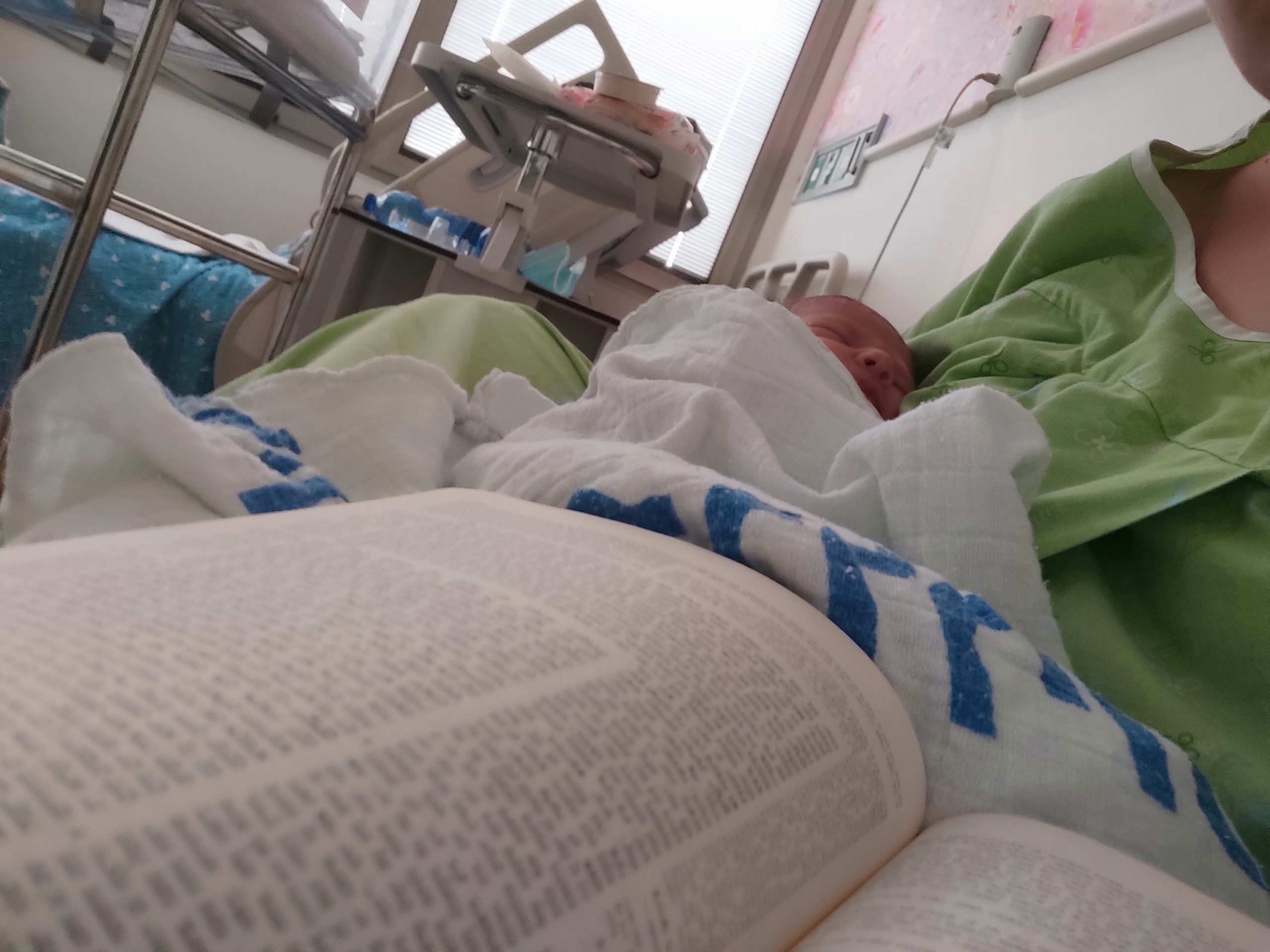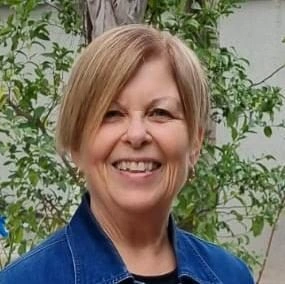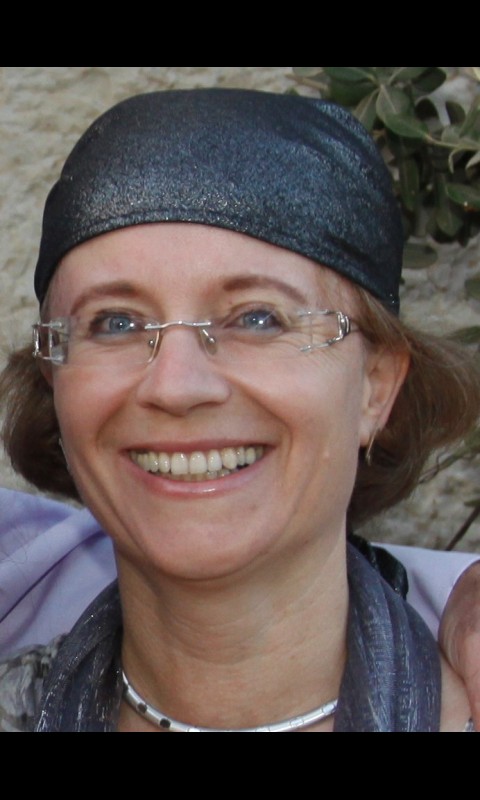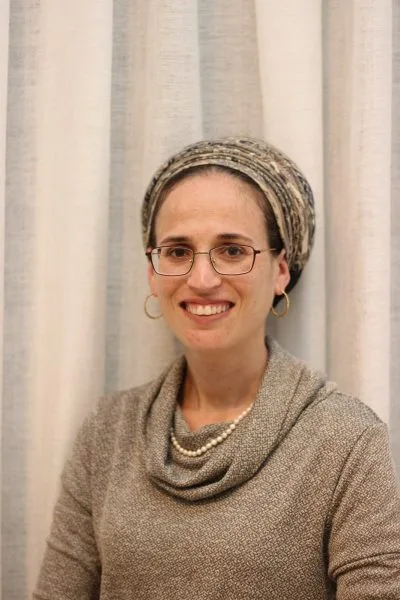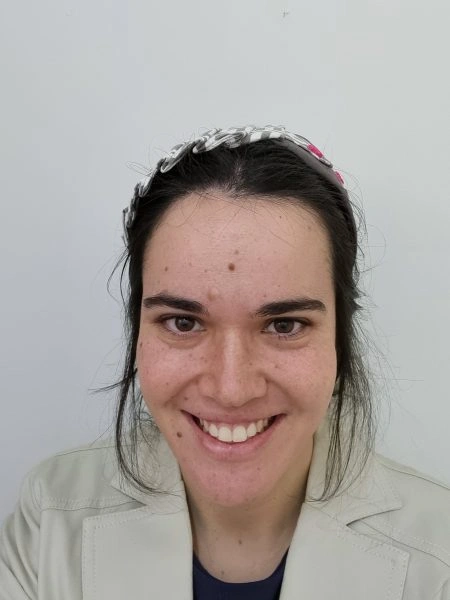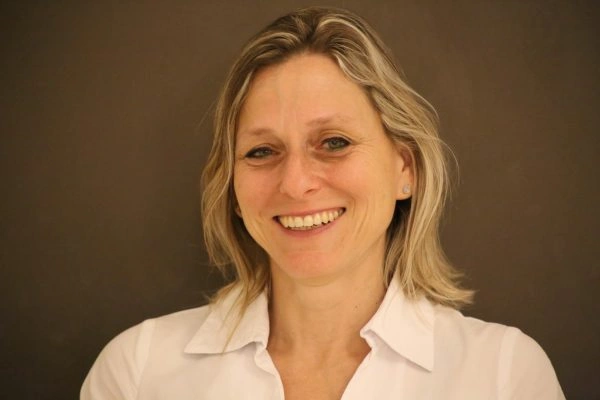רוצים להקדיש למידה? התחל כאן:
העמקה
רוצה להבין מה באמת קורה מתחת לפני השטח של הסוגיה?
שיעורים, פודקאסטים והרחבות של מיטב המורות שלנו יפתחו לך עוד זוויות וכיווני חשיבה.
חדשה בלימוד הגמרא?
זה הדף הראשון שלך? איזו התרגשות עצומה! יש לנו בדיוק את התכנים והכלים שיעזרו לך לעשות את הצעדים הראשונים ללמידה בקצב וברמה שלך, כך תוכלי להרגיש בנוח גם בתוך הסוגיות המורכבות ומאתגרות.
פסיפס הלומדות שלנו
גלי את קהילת הלומדות שלנו, מגוון נשים, רקעים וסיפורים. כולן חלק מתנועה ומסע מרגש ועוצמתי.
עבודה זרה מ״ח
מַתְנִי׳ שָׁלֹשׁ אֲשֵׁרוֹת הֵן — אִילָן שֶׁנְּטָעוֹ מִתְּחִלָּה לְשֵׁם עֲבוֹדָה זָרָה, הֲרֵי זוֹ אֲסוּרָה. גִּידְּעוֹ וּפִיסְּלוֹ לְשֵׁם עֲבוֹדָה זָרָה וְהֶחְלִיף — נוֹטֵל מַה שֶׁהֶחְלִיף. הֶעֱמִיד תַּחְתֶּיהָ עֲבוֹדָה זָרָה וּנְטָלָהּ — הֲרֵי זוֹ מוּתֶּרֶת.
MISHNA: There are three types of trees that were used as part of idolatrous rites [ashera]: A tree that one initially planted for the sake of idol worship is forbidden, and one may not derive benefit from any part of the tree. If one lopped off part of the trunk of a tree or trimmed its branches for the sake of idol worship, i.e., to worship that which would regrow there, and the tree’s trunk or limbs regrew, one removes that which has regrown and burns it. The remainder of the tree is then permitted. If one erected an object of idol worship beneath a tree and subsequently removed it, it is permitted to derive benefit from the tree.
גְּמָ׳ אָמְרִי דְּבֵי רַבִּי יַנַּאי: וְהוּא שֶׁהִבְרִיךְ וְהִרְכִּיב בְּגוּפוֹ שֶׁל אִילָן.
GEMARA: The mishna teaches that if one lopped off or trimmed a tree’s branches for the sake of idol worship and it regrew, the tree is permitted upon the removal of the new growth. The Sages of the school of Rabbi Yannai say: And this is the halakha only when one sank the shoot of a vine into the ground or grafted onto the trunk of the tree itself.
וְהָאֲנַן ״גִּידְּעוֹ וּפִיסְּלוֹ״ תְּנַן!
The Gemara asks: But didn’t we learn that if he lopped off part of the trunk or trimmed the tree’s branches, the growth is forbidden? In order to render a tree forbidden, according to the Sages of the school of Rabbi Yannai, the act dedicated to idol worship must be sinking or grafting, which are tantamount to replanting the entire tree. The mishna indicates that even cutting off part of a tree renders the new growth forbidden.
אֶלָּא כִּי אִיתְּמַר דְּרַבִּי יַנַּאי, לְעִנְיַן בִּיטּוּל אִיתְּמַר, דְּאַף עַל גַּב דְּהִבְרִיךְ וְהִרְכִּיב בְּגוּפוֹ שֶׁל אִילָן, כִּי נָטַל מַה שֶּׁהֶחְלִיף — שַׁפִּיר דָּמֵי, דְּמַהוּ דְּתֵימָא: כֵּיוָן דְּהִבְרִיךְ וְהִרְכִּיב בְּגוּפוֹ שֶׁל אִילָן כְּאִילָן שֶׁנְּטָעוֹ מִתְּחִלָּה דָּמֵי, וְלִיתְּסַר כּוּלַּהּ, קָא מַשְׁמַע לַן.
The Gemara answers: Rather, when the statement of the Sages of the school of Rabbi Yannai was stated, it was stated with regard to the revocation of the idolatrous status. What they meant to say was that even if one sank the shoot of a vine into the ground or grafted onto the tree itself, effecting a more significant change, nevertheless, when one removes that which has regrown, the tree is permitted. As, lest you say that since one sank the shoot of a vine into the ground or grafted onto the tree itself, it is similar to a tree that one initially planted for idol worship and the entire tree should be forbidden, the Sages of the school of Rabbi Yannai counter this and teach us that even in this case the tree is permitted when that which has regrown is removed.
אָמַר שְׁמוּאֵל: הַמִּשְׁתַּחֲוֶה לְאִילָן, (תּוֹסֶפְתֵּיהּ) [תּוֹסַפְתּוֹ] אֲסוּרָה. מֵתִיב רַבִּי אֶלְעָזָר: גִּידְּעוֹ וּפִיסְּלוֹ לַעֲבוֹדָה זָרָה וְהֶחְלִיף — נוֹטֵל מַה שֶׁהֶחְלִיף. גִּידְּעוֹ וּפִיסְּלוֹ — אִין, לֹא גִּידְּעוֹ וּפִיסְּלוֹ — לֹא!
Shmuel says: In the case of one who bows to a tree, its additional subsequent growth is forbidden. Rabbi Elazar raises an objection from the mishna: If one lopped or trimmed the tree for the sake of idol worship and the tree’s trunk or limbs regrew, one removes that which has regrown and burns it. This indicates that if one lopped or trimmed it the additional growth is forbidden, but if one did not lop or trim it, even if one bowed to the tree, the growth is not forbidden.
אָמַר לְךָ שְׁמוּאֵל: הָא מַנִּי? רַבָּנַן הִיא, וּשְׁמוּאֵל דְּאָמַר כְּרַבִּי יוֹסֵי בַּר יְהוּדָה, דְּאָמַר: אִילָן שֶׁנְּטָעוֹ וּלְבַסּוֹף עֲבָדוֹ — אָסוּר.
The Gemara answers that Shmuel could say to you: In accordance with whose opinion is this mishna? It is in accordance with the opinion of the Rabbis, who maintain that a tree that was planted and only subsequently worshipped is permitted, as it was not initially planted for idol worship. And Shmuel says his statement in accordance with the opinion of Rabbi Yosei bar Yehuda, who says that a tree that one planted and subsequently worshipped is forbidden. Accordingly, bowing to a tree renders its subsequent growth forbidden.
מַתְקֵיף לַהּ רַב אָשֵׁי: מִמַּאי דְּרַבִּי יוֹסֵי בַּר יְהוּדָה וְרַבָּנַן בְּתוֹסֶפֶת פְּלִיגִי? דִּלְמָא תּוֹסֶפֶת לְדִבְרֵי הַכֹּל אָסוּר, וּבְעִיקָּרוֹ פְּלִיגִי.
Rav Ashi objects to this answer: From where is it derived that Rabbi Yosei bar Yehuda and the Rabbis disagree with regard to additional growth? Perhaps all agree that additional growth after the tree was worshipped is forbidden, and they disagree only with regard to its trunk.
דְּרַבִּי יוֹסֵי בַּר יְהוּדָה סָבַר: עִיקָּרוֹ נָמֵי אָסוּר, דִּכְתִיב: ״וַאֲשֵׁרֵיהֶם תִּשְׂרְפוּן בָּאֵשׁ״, וְרַבָּנַן סָבְרִי: עִיקַּר אִילָן שְׁרֵי, דִּכְתִיב: ״וַאֲשֵׁירֵהֶם תְּגַדֵּעוּן״. אֵיזֶהוּ אִילָן שֶׁגִּידּוּעוֹ אָסוּר וְעִיקָּרוֹ שְׁרֵי? הֱוֵי אוֹמֵר: אִילָן שֶׁנְּטָעוֹ וּלְבַסּוֹף עֲבָדוֹ!
The Gemara explains what the nature of this dispute would be: As Rabbi Yosei bar Yehuda maintains that its trunk is also forbidden, as it is written: “And you shall break down their altars, and dash in pieces their pillars, and burn their asherim with fire” (Deuteronomy 12:3). Burning with fire destroys the whole tree, which indicates that the entire tree is forbidden, including its trunk. And the Rabbis maintain that the trunk of the tree is permitted, as it is written: “You shall break down their altars, and dash in pieces their pillars, and hew down their asherim, and burn their graven images with fire” (Deuteronomy 7:5). Which is the tree whose hewn part is forbidden, but its trunk is permitted? You must say it is a tree that one planted and subsequently worshipped.
וְכִי תֵּימָא: הָא דְּלָא מְתָרְצִינַן הָכִי — אֵיפוֹךְ רַבָּנַן לִדְרַבִּי יוֹסֵי בַּר יְהוּדָה, וּדְרַבִּי יוֹסֵי בַּר יְהוּדָה לְרַבָּנַן!
And if you would say that we did not explain their opinions in this manner previously (45b), as the source given there for the opinion of Rabbi Yosei bar Yehuda is the same verse given here as the source for the opinion of the Rabbis, simply reverse the explanation given there to match the one given here. The verse cited there as the source for the opinion of the Rabbis, namely, “and burn their asherim with fire,” should instead be considered the source for the opinion of Rabbi Yosei bar Yehuda, who deems even the trunk of a subsequently worshipped tree forbidden. And the verse cited there as the source for the opinion of Rabbi Yosei bar Yehuda, namely, “and hew down their asherim,” should instead be considered the source for the opinion of the Rabbis that only subsequent growth is forbidden.
אִם כֵּן, גִּידְּעוֹ וּפִיסְּלוֹ, מַאן קָתָנֵי לַהּ? לָא רַבָּנַן וְלָא רַבִּי יוֹסֵי בַּר יְהוּדָה! אִי רַבָּנַן — בְּלֹא גִּידְּעוֹ וּפִיסְּלוֹ נָמֵי תּוֹסֶפֶת אֲסוּרָה, אִי רַבִּי יוֹסֵי בַּר יְהוּדָה — עִיקַּר אִילָן נָמֵי אָסוּר!
The Gemara rejects Rav Ashi’s suggestion: It cannot be that all agree that additional growth is forbidden when a tree is planted and subsequently worshipped, because if so, who teaches the mishna that says that the tree is forbidden when one lopped it or trimmed it? It is neither the Rabbis nor Rabbi Yosei bar Yehuda. If one were to say that the Rabbis teach it, this cannot be, as they maintain that even in a case where one did not lop it or trim it, but simply bowed to it, the additional growth is forbidden. If one were to say that Rabbi Yosei bar Yehuda teaches the mishna, this cannot be, as he maintains that even the trunk of the tree is forbidden after it has been worshipped, and not just the subsequent growth.
אִי בָּעֵית אֵימָא רַבָּנַן, וְאִי בָּעֵית אֵימָא רַבִּי יוֹסֵי בַּר יְהוּדָה. אִי בָּעֵית אֵימָא רַבִּי יוֹסֵי בַּר יְהוּדָה — כִּי קָאָמַר רַבִּי יוֹסֵי בַּר יְהוּדָה בְּלֹא גִּידְּעוֹ וּפִיסְּלוֹ עִיקַּר אִילָן אָסוּר בִּסְתָמָא, אֲבָל גִּידְּעוֹ וּפִיסְּלוֹ — גַּלִּי אַדַּעְתֵּיהּ דִּבְתוֹסֶפֶת נִיחָא לֵיהּ, בְּעִיקַּר אִילָן לָא נִיחָא לֵיהּ.
The Gemara responds, defending Rav Ashi’s suggestion: If you wish, say that the Rabbis teach the mishna, and if you wish, say that Rabbi Yosei bar Yehuda teaches it. The Gemara explains each possibility: If you wish, say that Rabbi Yosei bar Yehuda teaches it, as when Rabbi Yosei bar Yehuda says that even in a case where one did not lop it or trim it, the trunk of the tree is nevertheless forbidden, it is only in a case where one worshipped the tree without specification, i.e., not any specific part of the tree. But if one lopped it or trimmed it for the sake of idol worship, he has revealed his intention, namely, that he believes that the additional growth is suitable for his idol worship, but that the trunk of the tree is not suitable for his idol worship. Therefore, in such a case only the additional growth is forbidden.
אִיבָּעֵית אֵימָא: רַבָּנַן, ״גִּידְּעוֹ וּפִיסְּלוֹ״ אִיצְטְרִיכָא לֵיהּ. סָלְקָא דַּעְתָּךְ אָמֵינָא: כֵּיוָן דַּעֲבַד לֵיהּ מַעֲשֶׂה בְּגוּפֵיהּ, עִיקַּר אִילָן נָמֵי לִיתְּסַר, קָמַשְׁמַע לַן.
The Gemara explains the other possibility. If you wish, say that the Rabbis teach it. Although they maintain that even without lopping or trimming the tree the additional growth is forbidden if it is worshipped, nevertheless it was necessary for the mishna to mention the case where one lopped it or trimmed it specifically. Otherwise, it might enter your mind to say that since one performed an action on the tree itself, the trunk of the tree should also be forbidden. Therefore, the mishna teaches us that only the additional growth is forbidden and not the trunk.
מַתְנִי׳ אֵיזוֹ אֲשֵׁרָה? כֹּל שֶׁיֵּשׁ תַּחְתֶּיהָ עֲבוֹדָה זָרָה. רַבִּי שִׁמְעוֹן אוֹמֵר: כֹּל שֶׁעוֹבְדִין אוֹתָהּ. וּמַעֲשֶׂה בְּצַיְדָּן בְּאִילָן שֶׁהָיוּ עוֹבְדִין אוֹתוֹ, וּמָצְאוּ תַּחְתָּיו גַּל. אָמַר לָהֶן רַבִּי שִׁמְעוֹן: בִּדְקוּ אֶת הַגַּל הַזֶּה, וּבְדָקוּהוּ וּמָצְאוּ בּוֹ צוּרָה. אָמַר לָהֶן: הוֹאִיל וְלַצּוּרָה הֵן עוֹבְדִין, נַתִּיר לָהֶן אֶת הָאִילָן.
MISHNA: Which tree is deemed forbidden as an ashera? Any tree that has an object of idol worship beneath it. Rabbi Shimon says: Any tree that people worship. And there was an incident in Tzaidan involving a tree that people would worship, and Jews found beneath it a heap of stones. Rabbi Shimon said to them: Examine this heap of stones. And they examined it and found in it an idolatrous image. Rabbi Shimon said to them: Since it is the image that they worship, we can permit use of the tree to those who wish to derive benefit from it.
גְּמָ׳ אֵיזֶהוּ אֲשֵׁרָה? וְהָא אֲנַן ״שָׁלֹשׁ אֲשֵׁרוֹת״ תְּנַן! הָכִי קָאָמַר: שְׁתַּיִם לְדִבְרֵי הַכֹּל, וְאַחַת מַחְלוֹקֶת דְּרַבִּי שִׁמְעוֹן וְרַבָּנַן. אֵיזוֹ הִיא אֲשֵׁרָה שֶׁנֶּחְלְקוּ בָּהּ רַבִּי שִׁמְעוֹן וַחֲכָמִים? כֹּל שֶׁיֵּשׁ תַּחְתֶּיהָ עֲבוֹדָה זָרָה, רַבִּי שִׁמְעוֹן אוֹמֵר: כֹּל שֶׁעוֹבְדִים אוֹתָהּ.
GEMARA: The mishna teaches: Which tree is an ashera? The Gemara asks: But didn’t we learn in the previous mishna that there are three types of ashera trees? The Gemara answers: This is what the mishna is saying: Of the three trees mentioned in the previous mishna, there are two where the trees themselves are worshipped, and everyone agrees that they are forbidden. And there is one that is subject to a dispute between Rabbi Shimon and the Rabbis. Which is the ashera with regard to which Rabbi Shimon and the Rabbis disagree? It is any tree that has an object of idol worship beneath it, as Rabbi Shimon says that any tree that people worship is forbidden, but that a tree under which an idol was placed is not forbidden.
אֵיזוֹ הִיא אֲשֵׁרָה סְתָם? אָמַר רַב: כֹּל שֶׁכּוֹמָרִים יוֹשְׁבִין תַּחְתֶּיהָ וְאֵין טוֹעֲמִין מִפֵּירוֹתֶיהָ. וּשְׁמוּאֵל אָמַר: אֲפִילּוּ אָמְרִי ״הָנֵי תַּמְרֵי לְבֵי נִצְרְפֵי״ — אָסוּר, דְּרָמֵי בֵּי שִׁיכְרָא וְשָׁתֵי לֵיהּ בְּיוֹם אֵידָם. אָמַר אַמֵּימָר: אֲמַרוּ לִי סָבֵי דְפוּמְבְּדִיתָא הִלְכְתָא כִּשְׁמוּאֵל.
The Gemara presents a question: Which tree is assumed to be an ashera, even without specific knowledge that it was worshipped? Rav says: Any tree that gentile priests sit beneath and do not taste of its fruits, as they apparently consider the fruits consecrated to the idol. And Shmuel says: Even if they so much as say: These dates are for the house of Natzrefei, a house of idol worship, the tree is forbidden. This is because the idol worshippers would throw the dates into beer and drink it on their festival day. Ameimar says: The elders of Pumbedita said to me that the halakha is in accordance with the opinion of Shmuel.
מַתְנִי׳ לֹא יֵשֵׁב בְּצִילָּהּ, וְאִם יָשַׁב — טָהוֹר, וְלֹא יַעֲבוֹר תַּחְתֶּיהָ, וְאִם עָבַר — טָמֵא. הָיְתָה גּוֹזֶלֶת אֶת הָרַבִּים וְעָבַר תַּחְתֶּיהָ — טָהוֹר.
MISHNA: With regard to an ashera, one may not sit in its shade, but if one sat in its shade he remains ritually pure. And one may not pass beneath it, and if one passed beneath it he is ritually impure. If the tree was robbing the public, i.e., if its branches extended over public property, and one passed beneath it, he remains pure.
גְּמָ׳ לֹא יֵשֵׁב בְּצִילָּהּ. פְּשִׁיטָא! אָמַר רַבָּה בַּר בַּר חָנָה אָמַר רַבִּי יוֹחָנָן: לֹא נִצְרְכָא אֶלָּא לְצֵל צִילָּהּ.
GEMARA: The mishna teaches: One may not sit in its shade. The Gemara asks: Isn’t this obvious? He is directly benefiting from an object of idol worship. Rabba bar bar Ḥana said that Rabbi Yoḥanan said: It is necessary only with regard to the shade of its shade. The shade that extends as far as the height of the tree is considered its shade. The less significant shade, that which extends further than the tree’s height, is referred to as the shade of its shade. The mishna is teaching that even this secondary shade is forbidden.
מִכְּלָל דִּבְצֵל קוֹמָתָהּ, אִם יָשַׁב — טָמֵא? לֹא, דַּאֲפִילּוּ לְצֵל קוֹמָתָהּ נָמֵי, אִם יָשַׁב — טָהוֹר, וְהָא קָא מַשְׁמַע לַן, דַּאֲפִילּוּ לְצֵל צִילָּהּ לֹא יֵשֵׁב.
The Gemara comments: By inference, with regard to the shade of its height, its primary shade, if one sat there he is impure. The Gemara rejects this inference: No, this inference is not correct, as even with regard to the shade of its height, if one sat there he remains pure. And this is what the mishna is teaching us: That even with regard to the shade of its shade, one may not sit in it.
אִיכָּא דְּמַתְנֵי לַהּ אַסֵּיפָא, וְאִם יָשַׁב טָהוֹר. פְּשִׁיטָא? אָמַר רַבָּה בַּר בַּר חָנָה אָמַר רַבִּי יוֹחָנָן: לֹא נִצְרְכָא אֶלָּא לְצֵל קוֹמָתָהּ. מִכְּלָל דִּלְצֵל צִילָּהּ אֲפִילּוּ לְכַתְּחִלָּה יֵשֵׁב? לָא, הָא קָא מַשְׁמַע לַן, דַּאֲפִילּוּ לְצֵל קוֹמָתָהּ אִם יָשַׁב — טָהוֹר.
There are those who teach this discussion with regard to the latter clause of that part of the mishna, which states: But if one sat in its shade he remains ritually pure. The Gemara asks: Isn’t this obvious? Why should he be rendered impure? Rabba bar bar Ḥana said that Rabbi Yoḥanan said: It is necessary only with regard to the direct shade of its height. Even in this case, he remains pure. The Gemara comments: By inference, with regard to the shade of its shade, one may even sit there ab initio. The Gemara answers: No, this inference is not correct. Rather, this is what the mishna is teaching us: That even with regard to the shade of its height, if one sat there he remains pure.
וְלֹא יַעֲבוֹר תַּחְתֶּיהָ, וְאִם עָבַר — טָמֵא. מַאי טַעְמָא? אִי אֶפְשָׁר דְּלֵיכָּא תִּקְרוֹבֶת עֲבוֹדָה זָרָה.
§ The mishna teaches: And one may not pass beneath an ashera, and if one passed beneath it he is ritually impure. The Gemara asks: What is the reason? The Gemara answers: Because it is impossible that there is no remnant of an idolatrous offering underneath the tree.
מַנִּי? רַבִּי יְהוּדָה בֶּן בְּתֵירָא הִיא, דְּתַנְיָא: רַבִּי יְהוּדָה בֶּן בְּתִירָא אוֹמֵר: מִנַּיִן לְתִקְרוֹבֶת עֲבוֹדָה זָרָה שֶׁמְּטַמְּאָה בְּאֹהֶל? שֶׁנֶּאֱמַר: ״וַיִּצָּמְדוּ לְבַעַל פְּעוֹר וַיֹּאכְלוּ זִבְחֵי מֵתִים״ — מָה מֵת מְטַמֵּא בְּאֹהֶל, אַף תִּקְרוֹבֶת עֲבוֹדָה זָרָה מְטַמֵּא בְּאֹהֶל.
The Gemara asks: Whose opinion is this? It is the opinion of Rabbi Yehuda ben Beteira, as it is taught in a baraita that Rabbi Yehuda ben Beteira says: From where is it derived that an idolatrous offering transmits impurity in a tent, i.e., to that which is under the same roof? It is derived from that which is stated: “And they joined themselves unto Ba’al-Peor, and ate the offerings to the dead” (Psalms 106:28). It is derived from here that just as a corpse transmits impurity in a tent, so too, an idolatrous offering transmits impurity in a tent.
הָיְתָה גּוֹזֶלֶת אֶת הָרַבִּים וְעָבַר תַּחְתֶּיהָ — טָהוֹר. אִיבַּעְיָא לְהוּ: עָבַר אוֹ עוֹבֵר? רַבִּי יִצְחָק בֶּן אֶלְעָזָר מִשְּׁמֵיהּ דְּחִזְקִיָּה אָמַר: עוֹבֵר, וְרַבִּי יוֹחָנָן אָמַר: אִם עָבַר.
§ The mishna teaches: If the tree was robbing the public and one passed beneath it he remains pure. A dilemma was raised before the Sages: Does the mishna mean that if one passed under the tree he remains pure, but that it is prohibited to pass beneath it ab initio? Or does the mishna mean that one may pass beneath it ab initio? Rabbi Yitzḥak ben Elazar says in the name of Ḥizkiyya: One may pass ab initio. And Rabbi Yoḥanan says: The mishna means that if one passed he remains pure, but it is prohibited to pass ab initio.
וְלָא פְּלִיגִי, הָא דְּאִיכָּא דִּירְכָּא אַחֲרִינָא, הָא דְּלֵיכָּא דִּירְכָּא אַחֲרִינָא.
The Gemara explains: And they do not disagree. This opinion, that one may not pass beneath an ashera, is referring to a case where there is another way to get to his destination. That opinion, that it is permitted to pass beneath it ab initio, is referring to a case where there is no other way.
אֲמַר לֵיהּ רַב שֵׁשֶׁת לְשַׁמָּעֵיהּ: כִּי מָטֵית לְהָתָם ״אַרְהֵיטְנִי״. הֵיכִי דָמֵי? אִי דְּלֵיכָּא דִּירְכָּא אַחֲרִינָא, לְמָה לִי ״אַרְהֵיטְנִי״? מִישְׁרָא שְׁרֵי! וְאִי דְּאִיכָּא דִּירְכָּא אַחְרִינָא, כִּי אָמַר ״אַרְהֵיטְנִי״ מִי שְׁרֵי?
The Gemara relates: Rav Sheshet, who was blind, was being guided by his attendant toward his city, and there was an ashera shadowing the path. Rav Sheshet said to his attendant: When you arrive at the ashera, have me run past it quickly. The Gemara asks: What were the circumstances? If there was no other way to get to his destination, why did Rav Sheshet request: Have me run past it? In such circumstances, it is permitted to walk normally underneath an ashera. And if there was another way to get to his destination, when Rav Sheshet said: Have me run past it, was it then permitted for him to do so? He still passed under the ashera.
לְעוֹלָם, דְּלֵיכָּא דִּירְכָּא אַחֲרִינָא, וְאָדָם חָשׁוּב שָׁאנֵי.
The Gemara answers: Actually, it was a case where there was no other way to get to his destination. And although it was permitted for Rav Sheshet to walk normally underneath the ashera, Rav Sheshet wanted to run past it because an important person is different. An important person should try to pass under the ashera as quickly as possible, lest others misunderstand the circumstances and learn from him that it is permitted for one to walk underneath an ashera even when there is another way for him to reach his destination.
מַתְנִי׳ זוֹרְעִין תַּחְתֶּיהָ יְרָקוֹת בִּימוֹת הַגְּשָׁמִים, אֲבָל לֹא בִּימוֹת הַחַמָּה, וְהַחֲזֵירִין לֹא בִּימוֹת הַחַמָּה וְלֹא בִּימוֹת הַגְּשָׁמִים. רַבִּי יוֹסֵי אוֹמֵר: אַף לֹא יְרָקוֹת בִּימוֹת הַגְּשָׁמִים, מִפְּנֵי שֶׁהַנְּבִיָּה נוֹשֶׁרֶת עֲלֵיהֶן וְהֹוָה לָהֶן לְזֶבֶל.
MISHNA: One may plant vegetables underneath an ashera during the rainy season, as the vegetables do not benefit from its shade; on the contrary, the tree’s foliage prevents the vegetables from being properly irrigated by the rain. But one may not plant vegetables under an ashera during the summer, as the shade benefits them. And lettuce may not be planted there at all, neither in the summer nor in the rainy season, because shade is always beneficial to lettuce. Rabbi Yosei says: One may not plant vegetables under an ashera even during the rainy season, because the tree’s foliage [shehaneviyya] falls upon them and serves as fertilizer for them.
גְּמָ׳ לְמֵימְרָא דְּרַבִּי יוֹסֵי סָבַר: זֶה וָזֶה גּוֹרֵם — אָסוּר, וְרַבָּנַן אָמְרִי: זֶה וָזֶה גּוֹרֵם — מוּתָּר?
GEMARA: The mishna records a dispute between Rabbi Yosei and the Rabbis with regard to planting underneath an ashera in the rainy season when vegetables are fertilized by the tree’s forbidden fallen foliage. As the plant is also fertilized by the permitted nutrients of the ground, the plant’s growth is caused by both prohibited and permitted sources. Therefore, the Gemara asks: Is this to say that Rabbi Yosei holds that when both this and that cause it, i.e., when both permitted and forbidden items contribute to a result, the result is forbidden, and he therefore holds that it is prohibited to plant underneath an ashera in the rainy season; and the Rabbis say that when both this and that cause a result, the result is permitted?
הָא אִיפְּכָא שָׁמְעִינַן לְהוּ, דִּתְנַן: רַבִּי יוֹסֵי אוֹמֵר: שׁוֹחֵק וְזוֹרֶה לָרוּחַ אוֹ מֵטִיל לַיָּם. אָמְרוּ לוֹ: אַף הִיא נַעֲשָׂה זֶבֶל, וְנֶאֱמַר: ״לֹא יִדְבַּק בְּיָדְךָ מְאוּמָה מִן הַחֵרֶם״.
Didn’t we hear that they stated the opposite rulings? As we learned in a mishna (43b): Rabbi Yosei says: When one encounters an idol, he should grind the idol and throw the dust to the wind or cast it into the sea. The Rabbis said to him: What is the good of that? That also gives a Jew benefit from the idol, as it becomes fertilizer for his crops, and deriving any kind of benefit is prohibited, as it is written: “And nothing of the proscribed items shall cleave to your hand” (Deuteronomy 13:18).
קַשְׁיָא דְּרַבָּנַן אַדְּרַבָּנַן, קַשְׁיָא דְּרַבִּי יוֹסֵי אַדְּרַבִּי יוֹסֵי!
The contradiction between the statement of the Rabbis in that mishna and the statement of the Rabbis in the mishna here is difficult, and the contradiction between the statement of Rabbi Yosei in that mishna and the statement of Rabbi Yosei here is difficult.
בִּשְׁלָמָא דְּרַבִּי יוֹסֵי אַדְּרַבִּי יוֹסֵי לָא קַשְׁיָא: הָתָם, דְּקָאָזֵיל לְאִיבּוּד — מַתִּיר, הָכָא, דְּלָא קָאָזֵיל לְאִיבּוּד — אָסוּר.
The Gemara explains: Granted, the contradiction between one statement of Rabbi Yosei and the other statement of Rabbi Yosei is not difficult. It may be resolved as follows: There, in the earlier mishna, since the ground-up idol is dispersed and is going to be completely lost, Rabbi Yosei permits deriving benefit from the fertilizer. By contrast, in the mishna here, where the fallen leaves are not going to be lost so quickly, as they fall together on top of the vegetables and provide direct benefit as fertilizer, deriving benefit from them is prohibited.
אֶלָּא דְּרַבָּנַן אַדְּרַבָּנַן קַשְׁיָא, אֵיפוֹךְ.
But the contradiction between one statement of the Rabbis and the other statement of the Rabbis is difficult. Therefore, the Gemara concludes: Reverse the attribution of the statements, so that the mishna teaches that it is the Rabbis who deem it prohibited to plant under an ashera in the rainy season, while Rabbi Yosei deems it permitted.
וְאִיבָּעֵית אֵימָא: לָא תֵּיפוֹךְ, דְּרַבִּי יוֹסֵי כִּדְשַׁנִּין, דְּרַבָּנַן כִּדְאָמַר רַב מָרִי בְּרֵיהּ דְּרַב כָּהֲנָא: מָה שֶׁמַּשְׁבִּיחַ בָּעוֹר — פּוֹגֵם בַּבָּשָׂר.
And if you wish, say instead: Do not reverse the statements. The contradiction between the statements of Rabbi Yosei can be resolved as we answered before. The contradiction between the statements of the Rabbis can be resolved in accordance with that which Rav Mari, son of Rav Kahana, says about an animal offering that became disqualified for sacrifice. The halakha is that this animal is sold and the proceeds are dedicated to the Temple treasury. One may not skin the hide of the animal whole even though this would make the hide more valuable than if it were cut up into pieces. Rav Mari, son of Rav Kahana, explains that this is because the value that is enhanced with regard to the hide is offset by the damage caused to the flesh. The process of skinning the hide devalues the animal’s flesh; therefore, there is no overall monetary gain for the Temple treasury.
הָכָא נָמֵי, מָה שֶׁמַּשְׁבִּיחַ בַּנְּבִיָּה, פּוֹגֵם בַּצֵּל.
Here too, the value that is enhanced with regard to the planted vegetables by the foliage of the tree is offset by the damage caused by its shade. Therefore, since there is no overall benefit gained from the ashera, the Rabbis deem it permitted to plant underneath it in the winter.
וְסָבַר רַבִּי יוֹסֵי זֶה וָזֶה גּוֹרֵם אָסוּר? וְהָתַנְיָא: רַבִּי יוֹסֵי אוֹמֵר: נוֹטְעִין יִחוּר שֶׁל עׇרְלָה, וְאֵין נוֹטְעִין אֱגוֹז שֶׁל עׇרְלָה, מִפְּנֵי שֶׁהוּא פֶּרִי. וְאָמַר רַב יְהוּדָה אָמַר רַב: מוֹדֶה רַבִּי יוֹסֵי שֶׁאִם נָטַע וְהִבְרִיךְ וְהִרְכִּיב — מוּתָּר.
The Gemara asks: And does Rabbi Yosei hold that when both this and that cause it, i.e., when both permitted and forbidden items contribute to a result, the result is forbidden? But isn’t it taught in a mishna (Orla 1:9) that Rabbi Yosei says: One may plant the branch of an orla tree, i.e., a tree during the first three years after its planting, despite the prohibition against eating or deriving benefit from its fruit; but one may not plant an orla nut, because it is a fruit. And Rav Yehuda says that Rav says: Rabbi Yosei concedes that if one planted an orla nut, or sank the shoot of an orla tree into the ground, or grafted an orla tree, deriving benefit from that which grows as a result is permitted. This is apparently because the growth is caused by both a forbidden cause, the orla nut, and a permitted cause, the ground’s nutrients.
וְתַנְיָא נָמֵי הָכִי: מוֹדֶה רַבִּי יוֹסֵי
The Gemara adds: And that which Rav Yehuda says that Rav says is also taught in a baraita: Rabbi Yosei concedes
